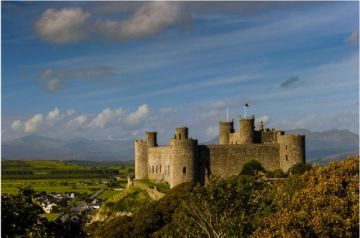Attractions - Accommodation - Tourist Information Centres
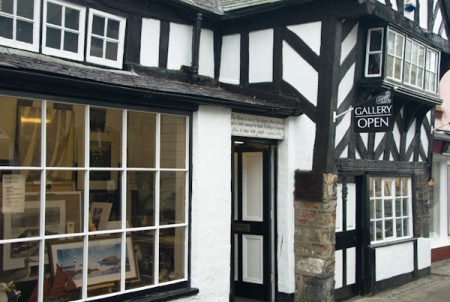
HISTORY
The Island of Anglesey was the last stronghold of the Druids, who
were finally eradicated here by the Roman conquerors around 63AD, and
the isle has been home to strange legends and myths ever since. King
Arthur is inevitably one of those myths (this is Wales,
after all).
Anglesey was considered sacred by the Welsh druids, and it was here that they retreated after the Roman invasion of 43 AD. The Roman soldiers were so fearful of the druid's reputed magical powers that some of the soldiers refused to cross the Menai Strait to the island.
Early Christian sites abound, perhaps the most important being Penmon Priory and St Seiriol's holy well, at the very south east corner of the island. Seiriol was a 6th century saint who established a monastic settlement here, later to be replaced by a medieval monastery. Behind the monastic buildings are the remains of a holy well, cut from solid rock. Within Penmon church are several early Christian crosses, most notably the Penmon Cross, a 10th century cross intricately carved with traditional Celtic interlace patterns.
The Romans built a watchtower atop Holyhead Mountain. Traces of the defenses can still be seen, but the most tangible evidence of Roman presence is Caer Gybi, an imposing fort built in the 3rd century to defend Holyhead harbour.
The seaside resort of Beaumaris is home to beautiful Georgian buildings lining the shore, and arguably the most scenic medieval castle in Wales. Edward I started Beaumaris Castle as part of his push to keep Wales subdued, but the castle's defenses were never finished, for the Welsh resistance melted away. Today Beaumaris remains ome of the most influential medieval fortressesfor its early use of concentric defenses, designed by Master James of St George, Edward's master mason.
Nearby is the elegant mansion of Plas Newydd, which stands a mere 2 miles from the village of Llanfair PG, blessed with [perhaps] the longest place name in the world (Llanfairpwllgwyngyllgogerychwyrndrobwllllantysiliogogogoch, which loosely translates as "St Mary's Church by the white aspen over the whirlpool and St Tysilio's Church by the red cave"). Plas Newydd, home of the Marquis of Anglesey, is an ivy clad jewel, housing a massive mural painted to order by Rex Whistler.
Anglesey is blessed with 125 miles of coastline, a mix of rocky headlands and sandy bays dotted with resort towns such as Moelfre and Trearddur Bay. The beaches at Newborough and Red Wharf Bay are particularly fine (and uncrowded). From Newborough Sands a level path leads along a narrow neck of land to magical Llanddwyn Island, site of an early nunnery established by St Dwynwyn, a Welsh version of St Valentine. A few steps from the nunnery are not one but two historic lighthouses.

NATURAL BEAUTY ...
The entire island of Anglesey has been
designated an AONB (Area of Outstanding Natural Beauty). There are also specially designated Heritage Coast areas at North Anglesey, Holyhead Mountain, and Aberffraw.
The island is joined to the mainland by the Menai Bridge, a pioneering suspension bridge designed by Thomas Telford. Telford was also responsible for the Stanley Embankment, built in 1822 to join Holy Island to mainland Anglesey. The embankment forms one side of the Inland Sea, a broad tidal lake enclosed on the other side by Four Mile Bridge.
ARCHAEOLOGY
Anglesey is so rich in prehistoric remains that it is hard to know where to start. Perhaps the most famous site is the ancient burial mound at Barclodiad y Gawres and Bryn Celli Dhu, but there are other burial sites at Din Dryfol and Lligwy, to name only two (see below for a full list). Holy Island is awash in ancient monuments, with standing stones at Penrhos Feilw, near South Stack, hut circles on the slope of Holyhead Mountain, and a burial chamber at Trefignath.
As always, we try to focus on historic places, but on Anglesey there's almost an embarassment of riches!
Castles
Beaumaris Castle
A beautiful late 13th century moated castle built by Edward I as part of his attempts to subdue the Welsh. Beaumaris was one of the high points of medieval military architecture.
Castell Aberlleiniog
A
Norman motte (castle mound), the only motte and bailey castle on Anglesey
Historic Houses
There's only one stately home of any note on Anglesey, but its a winner ...
Plas Newydd
One of the finest country houses in Britain, Plas Newydd (not to be confused with the house of the same name near Llangollen) is the home of the home of the Marquis of Anglesey. Plas Newydd was built in the late 18th century to a design by James Wyatt. It is a peculiar mix of neo-classical and Gothic styles. The most interesting feature of Plas Newyd is a huge mural painted by artist Rex Whistler. The house is set in superb gardens famous for its rhododenron and Italian rose gardens.
Religious sites
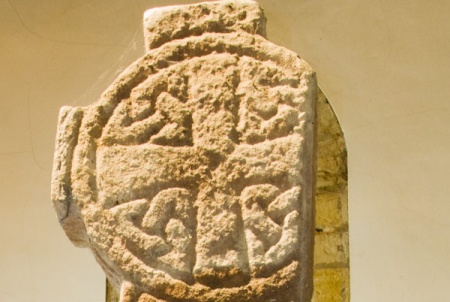
Penmon Priory
We'll mention the best first ... there is so much history crammed into this small site it is hard to know where to begin. At the core of the Penmon site is a 6th century priory founded by the saints Cynlas and Seiriol. A later 12th century Augustinan monastery was built on the site of the earlier priory. In Penmon church is the superb 10th century Penmon Cross and across the road is a restored 16th century dovecot. A short stroll from the priory brings you to an ancient holy well, said to have been built by St Seiriol. a medieval well housing protects a secluded pool of clear water welling from deep underground.
Beaumaris Church
Within easy walking distance of Beaumaris Castle, this 14th century church was built for the garrison of Beaumaris Castle. The interior features nicely carved 16th century choir stalls with misericords, a 15th century table tomb and the stone coffin of Princess Joan, wife of Llywelyn the Great and daughter of King John of England.
Church in the Sea
This picturesque 12th-century church near Aberffraw stands on an island that can only be accessed by a stone causeway at low tide.
Hen Capel Lligwy
A ruined 12th century chapel near Moelfre, now standing roofless. From the chapel a trail leads to the Romano-British settlement of Din Lligwy, while just across the lane is Lligwy Neolithic cromlech.
Holyhead, St Cybi
This 13th century church stands within the foundations of the 3rd century Roman fort of Caer Gybi.
The chancel dates to the 13th century but most of the church is 15th-16th century.
Llanbadrig
Situated in a dramatic clifftop location, the church is said to have been founded in the 5th century by St Patrick, who was shipwrecked near here..
Llaneilian Church
Perhaps the best preserved example of Anglesey's medieval churches, Llaneilian is a largely 15th century church with an earlier 14th century chapel constructed over the site of St Elian's original 6th century cell. The interior has a carved oak screen and further carvings on the roof beams.
Llangadwaladr, St Cadwaladr's Church
The burial place of King Cadfan of Gwynedd, who died around 625 AD. The Cadfan Stone, a 7th century carved memorial, is set into the north wall. The east window boasts the only substantial medieval stained glass on Anglesey.
Llanallgo, St Gallgo's Church
A cruciform church with a 15th century chancel, transepts and windows. Closely linked with the Royal Charter maritime disaster.
Nature
South Stack lighthouse
An early 19th century lighthouse reached by a set of 400 steep stairs from the Holy Island mainland - frequent tours. An RSPB nature reserve is immediately beside the lighthouse site.
Cemlyn Nature Reserve
Run by the North Wales Wildlife Trust, Cemlyn centres on a lagoon created by Captain Vivian Hewitt in the 1930s. Hewiit built a dam and weir to create a habitat for wildfowl. The lagoon is fronted by a long shingle beach. external link
Aside from the above, there are numerous long stretches of sandy beaches (try Newborough Sands!)
Prehistoric sites
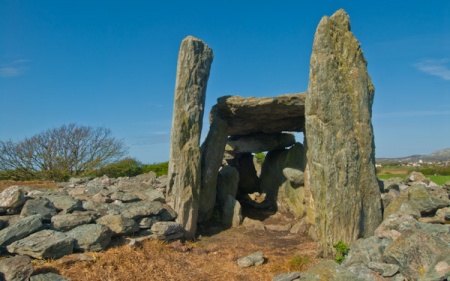
Anglesey is fantastically well-supplied with ancient sites, from burial mounds to standing stones, chambered tombs to ancient settlements, everywhere you look is evidence of the ancient inhabitants of the island
Barclodiad y Gawres
Aarguably the most important prehistoric site in the north of Wales, Barclodiad y Gawres is a one of the largest Neolithic tombs in Wales. Within the huge mound are stones etched with unique spiral carvings
Bodowyr Burial Chamber
One of the most accessible prehistoric sites on anglesey, Bodowyr is a Neolithic passage grave with three large upright stones supporting a capstone.
Bryn Celli Dhu
One of the best preserved megalithic tombs in Britain. The tomb was once surrounded by a stone circle, but only a single standing stone remains before the tomb entrance.
Bryn Gwyn Standing Stones
Only two stones remain of what was once a large stone circle 40 feet in diameter. These are among the tallest standing stones in Wales, at 13 feet and 10 feet.
Caer Leb
A prehistoric enclosure bounded by double banks and ditches. Probably built in the 2nd century BE, Caer Leb remained in use into the Roman period.
Castell Bryn Gwyn
A fortified enclosure, probably dating to the Neolithic period, Bryn Gwyn was used throughout the Iron Age and into the Roman period.
Din Dryfol Chambered Tomb
A Neolithic chambered tomb in a lonely farmer's field near Bethel. The site was used built about 3000 BC with only one chamber, then extended and adapted to create four small burial chambers.
Din Lligwy ancient settlement
A Romano-British setttlement composed of very well-preserved stone huts inside a stone wall enclosure. The settlement at Din Lligwy probably predates the Roman invasion, but many of the buildings date from the 4th century. Some of the huts probably workshops, and there is evidence of iron smelting on the site.
Holyhead Mountain Hut Circles
Over 20 huts with stone very well-preserved foundations, on the western slope Holyhead Mountain. This is one of the best preserved hut circles in Wales.
Lligwy Burial Chamber
A Neolithic cromlech with a huge capstone on top of eight small uprights. The capstone is massive, weighing 25 tonnes and measuring 18 feet by 15 feet. Erected around 3000 BC, Lligwy served as a location for communal burials.
Penrhos Feilw Standing Stones
A pair of large standing stones at the base of Holyhead Mountain. The stones were erected about 2000 BC and both stand 10-11 feet high. The stones may be part of an intentional alignment, possibly toward Snowdonia or, alternatively, toward Holyhead Mountain.
Presaddfed Burial Chamber
A pair of chambers of a are all that remain of a Neolithic burial site. One chamber has collapsed, but the other still has its capstone. Presaddfed was in use between 4000 and 2000 BC as a communal burial site.
Soar Standing Stone
A single stone is about 3 metres high and 0.4 metres thick. It stands in a field beside the A5025 near Llanfaethlu.
Ty Mawr Standing Stone
A single standing stone in a field just outside Holyhead. The stone is 9 feet tall and was probably dates to the Bronze Age. Located very close to the Trefignath Burial Chamber .
Ty Newydd Burial Chamber
A very worn Neolithic chambered tomb near Llanfaelog, with four short stones supporting a large capstone to create a small chamber. The capstone is huge, about 13 feet long and 5 feet wide.
Trefignath Burial Chamber
A prehistoric burial site beside the A55 on Holy Island. The Neolithic tomb was built in three phases, beginning about 3750 BC and ending about 2250 BC.
Tregwehelydd Standing Stone
A broken stone, now restored and bound with iron straps atop a concrete base. The stone stands on a hill above the River Alaw. A second stone is about 10 feet away, and likely formed a pair with the Tregwehelydd stone. The stone was probably erected between 2000 and 1500 BC.
Historic Buildings and other sites
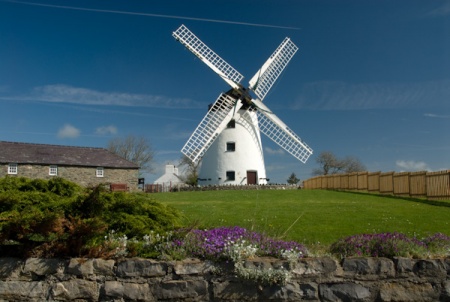
Llynnon Mill
The only working windmill on Anglesey, Llynnon is a fascinating glimpse into the past - and not just a glimpse at milling, for in the grounds are recreations of authentic Iron Age huts, such as might have been used by inhabitants of Anglesey before the coming of the Romans. The mill itself dates to 1775, and stands roughly 30 feet tall. It is still grinding flour, which you can purchase in the small shop.
Llys Rhosyr
An intriguing site near Newborough, probably a royal court of the Princes of Gwynedd. Llys Rhosyr is the only royal palace of the Welsh princes where the building foundations have remained nearly intact. Llys Rhosyr was a 'llysoed', a kind of court established by Llewelyn Fawr, the immensely powerful 13th century Prince of Gwynedd.
Llanddwyn Island
There are
some places that just have a little something about them; something special, a sort of aura of antiquity and mystery. Llanddwyn Island is just such a place. The tidal island is joined to Newborough Sands by a long, slender neck of land. It was to this lonely place sticking out into the Menai Strait that St Dwynwyn came in the 5th century to establish a nunnery. Her hermitage became a destination for pilgrims, and especially for lovers. Much later, a 16th century chapel was built on the site of Dwynwyn's hermitage. Almost beside the chapel site is an 18th century lighthouse and its replacement rected in 1845.
Roman sites
Caer y Twr, Holyhead Mountain Watch-tower
The name 'Caer y Twr' translates loosely as 'Tower fortress', which is just what it is. The Romans established a post atop the mountain to keep an eye on the Irish Sea and spot any approaching danger.
Caer Gybi
Built between the 3rd and 4th centuries AD, Caer Gybi. The foundation walls are hugely impressive; up to 6 feet thick in places. Within the walls of the Roman fort is a 13th century church.
Aberffraw Roman Fort
A 1st century Roman fort, with two occupation phases.
Towns and villages
Holyhead
Holyhead is the major settlement on Holy Island (not to be confused with Holy Island in Northumberland). The town is blessed with a natural harbour
which made it the obvious terminus for crossings of the Irish Sea, begining as far back as 2000 BC. The Roman invaders of Wales were quick to realise the importance of Holyhead. They extended the natural features of Holyhead harbour, and estalished a watchtower atop the mountain which rises above the town. They built a much larger fort at Caer Gybi. Within the 6 foot thick walls of the Roman fort stands the remains of a 13th century church dedicated to St Cybi.
Near the harbour entrance is Salt Island, where salt was mined in the 18th century. On the far slope of Holyhead mountain are ancient hut circles that indicate a sizeable settlement as far back as 2000 BC. From the base of the mountain the cliffs fall away sharply. On a rocky island just offshore is South Stack lighthouse.
Beaumaris
Edward I choose this marshy site on the south east coast of Anglesey to build a castle to defend the Menai Straits. Before the castle there was little in the way of a settlement, but it was not long before a sizeable town grew up around Edward's fortress. Today Beaumaris is a fascinating mix of timber-framed medieval buildings and Victorian terraces. Across from the castle is the County Hall, where assizes were held until 1971.
One of the oldest buildings in Beaumaris is the Bull's Head, built in 1472, which boasts perhaps the widest door in Britain, spanning 11 ft and rising 13 feet high (that's 3.35 metres and 4 metres to you youngsters out there who don't speak 'non-metric'. The 14th century church of St Nicholas is a gem, boasting the carved stone coffin of Joan (d. 1237), wife of Llewelyn the Great and daughter of King John
ACCOMMODATION
There are certainly reasonable numbers of hotels, bed and breakfasts, and guest houses on Anglesey, but it is self catering that really provides the most accommodation options for visitors. The sheer number of holiday cottages to let on the island indicates the popularity of Anglesey as a family holiday destination. No matter whether you need a cottage for a small family or a large group, there are plenty of alternatives to choose from.
Self Catering Accommodation
Showing the number of cottages in each location.
Aberffraw (2)
Abersoch (2)
Amlwch (15)
Amlwch Port (2)
Beaumaris (35)
Benllech (64)
Bodorgan (2)
Brynsiencyn (10)
Brynteg (1)
Bryntwrog (1)
Bull Bay (4)
Caergeiliog (1)
Capel Parc (2)
Carreglefn (1)
Cemaes Bay (36)
Church Bay (2)
Dulas (3)
Dwyran (2)
Four Mile Bridge (1)
Gaerwen (2)
Holyhead (12)
Llanddaniel Fab (2)
Llanddeusant (2)
Llanddona (2)
Llandegfan (3)
Llanedwen (1)
Llanerchymedd (11)
Llanfachraeth (4)
Llanfaelog (1)
Llanfaethlu (7)
Llanfair-yn-Neubwll (1)
Llanfairpwll (1)
Llanfairpwllgwyngyll (8)
Llanfairyngnhornwy (1)
Llanfechell (7)
Llangaffo (2)
Llangefni (6)
Llangoed (8)
Llanynghenedl (1)
Malltraeth (4)
Marianglas (1)
Menai Bridge (30)
Moelfre (17)
Newborough (19)
Penmon (1)
Penmynydd (2)
Pentraeth (9)
Pentre Berw (1)
Red Wharf Bay (10)
Rhoscolyn (5)
Rhosgoch (1)
Rhosneigr (39)
Rhosybol (1)
Rhydwyn (2)
Trearddur Bay (45)
Tynygongl (2)
Valley (7)
Y Felinheli (1)
